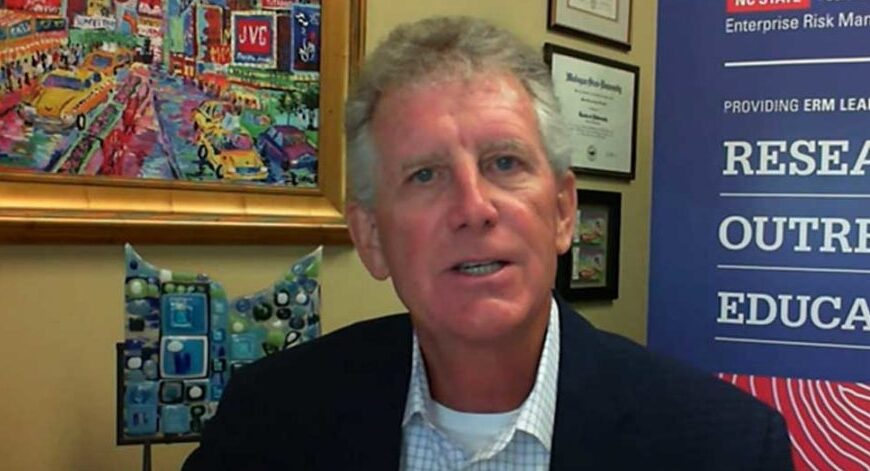Mark Beasley, KPMG Professor and Director of the ERM Initiative in the Poole College of Management at NC State University discusses how applying ERM core principles helped organizations manage the multitude of risks triggered by COVID-19. Hosted by the Raleigh Chamber of Commerce, Mark outlined how key concepts from enterprise risk management might provide a framework for organizing how we prioritize and respond to the most critical risks triggered by COVID-19. He highlighted tips for managing risks for the “Here and Now” and for later when we rebuild once COVID-19 is behind us.
Beasley Outlined these key points:
The Here and Now
- Focus on your people first – employees, customers, suppliers, partners – get them to a place of safety and where they feel some sense of security.
- Pinpoint your organization’s most critical driver of its business value. Identify what is your organization’s most important crown jewel for survivability. Is it the ability to deliver a key product or a core service, is it your online platform, is it your R&D?
- Identify the core elements that are needed to keep that critical driver of value for your organization in play:
- What must go right to keep that core value driver working? Who are the critical people needed and what are the core processes and technologies that need to function? How can I get those element working, even at a basic level?
- What assumptions are we having to make about our ability to get this critical driver back in play? Is my assumption valid? Might it change? If so, what would be my next move?
- Seek input from multiple people across the enterprise – don’t try to solve this challenge without multiple lenses on how certain actions might trigger issues across the enterprise. Obtaining an enterprise view of the risks and the proposed response will increase our odds of being able to navigate risks that may emerge as we implement new processes to keep things moving. Engaging multiple people in the risk thinking will help us be more proactive about recognizing bumps along the way sooner versus later.
- Communicate often and frequently. One of the most valuable aspects of an effective ERM process is that it leads to richer and more robust conversations about risks that might impact a business. Communication is key in ERM and it is even more important in this COVID-19 crisis. So, communicate often with your key people. As they are scattered and remotely connected, communication is even more critical. Get information to them frequently, but don’t forget to do so with compassion, empathy, and patience. Let this COVID-19 event enhance (versus destroy) your organization’s culture.
Assess the Damage and then Focus on Rebuilding After COVID-19
- Once we get the basics of our enterprise up and running in this pandemic crisis, it will be time to think about our near-term survivability. That means we need to gather some high level analysis of the financial impact of our business and how that might affect our organization’s liquidity and ability to financially sustain operations. Things are moving at the Federal level that will hopefully provide some basic relief for the near-term. Let’s keep a close eye on those developments and tap into them quickly.
- Conduct some basic cash flow analyses and forecasting to get a high level view of the potential financial damage that will be the new reality due to lost revenues and ongoing and potentially increasing costs. This will be a moving target to be updated regularly. Consider developing some “worst case, possible case, best case” liquidity scenarios to at least get a sense for the range of possible impact. Update that regularly, but don’t get paralyzed by the initial answers. Keep moving.
- Reach out to your key partners who might be able to help with the financial side of things. Perhaps some vendors can work with your organization regarding payment options and bankers and other capital providers may be in a position to help patchwork the financial situation for a short while. Having a sense for your organization’s biggest commitments and engaging in conversations now with the key players related to those commitments may put you in a better position than if you ignore those tough calls for a while.
- Leverage learnings from this event to build processes that will put our organizations in a stronger position when the next unknown crisis appears. Once we get through this crisis, our natural tendency will be to give a huge sigh of relief and relax. And, we should. But, while we will be anxious to return to normal, we don’t want to lose this opportunity to rethink and evaluate our enterprise’s risk management approach going forward.
- Invest in ERM processes that will put your organization in a position to proactively manage risks that might impact your business’s strategic success for long-term survivability.
The Raleigh Chamber of Commerce website has some additional resources related to managing the COVID-19 crisis.
Note: Given bandwidth challenges when recording the event, the video may “freeze” the image of Mark in a couple of spots. However, you will be able to hear him and it will eventually return to normal viewing. So, allow the video to run throughout.
- Categories:
- Types:



